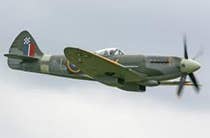Spitfire Dig To Continue At Second Site
Undaunted by a failure to find any buried Spitfires at the first dig site in Burma, project leader David Cundall said he is ready to start excavating a second site. Cundall said he will be flying soon to Myitkyina, about 900 miles from the first dig site. A preliminary dig at Myitkyina found a buried wooden crate filled with water, and Cundall hopes further excavation there will find airplanes. Cundall also said that excavation at the first site, at Yangon Airport, was stymied when officials prevented crews from digging more than five feet deep, to prevent damage to airport infrastructure such as pipes and cables. Cundall had said he wanted to go to at least 20 feet deep.

Undaunted by a failure to find any buried Spitfires at the first dig site in Burma, project leader David Cundall said he is ready to start excavating a second site. Cundall said he will be flying soon to Myitkyina, about 900 miles from the first dig site. A preliminary dig at Myitkyina found a buried wooden crate filled with water, and Cundall hopes further excavation there will find airplanes. Cundall also said that excavation at the first site, at Yangon Airport, was stymied when officials prevented crews from digging more than five feet deep, to prevent damage to airport infrastructure such as pipes and cables. Cundall had said he wanted to go to at least 20 feet deep.
If the second site proves unfruitful, Cundall has identified at least one other site in Burma where he hopes to excavate. He also may return to the first site and continue digging by hand, if officials will allow it, to assure no damage is done. Cundall, a British farmer, has been hunting for the lost Spitfires since 1996. He believes that the British military packed more than 120 Spitfires in crates and buried them in the ground before vacating Burma more than 60 years ago at the end of World War II.






